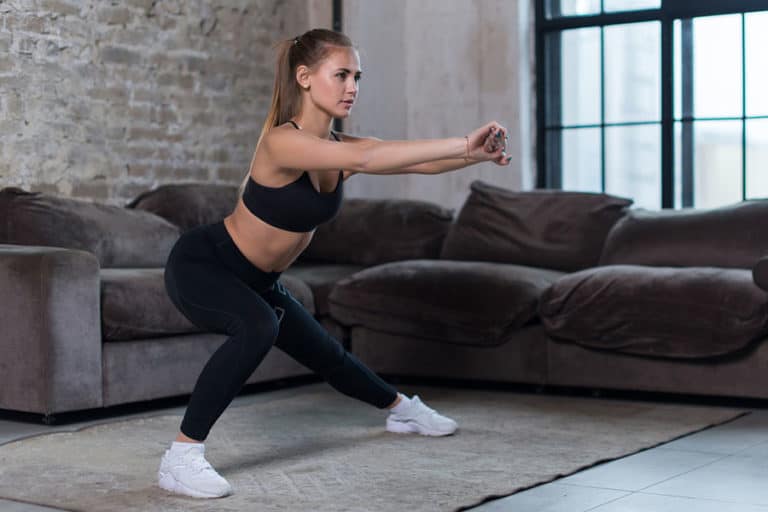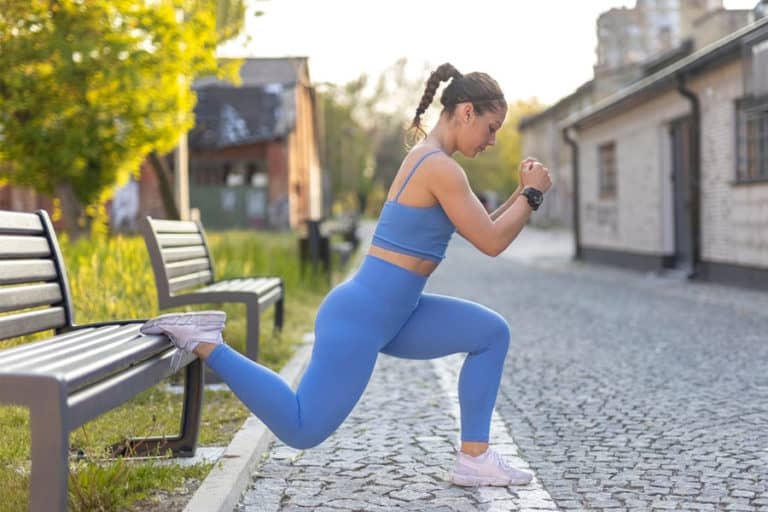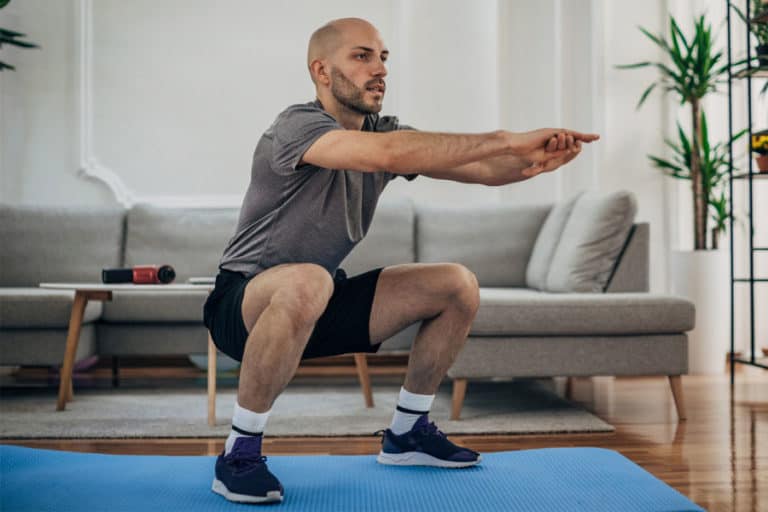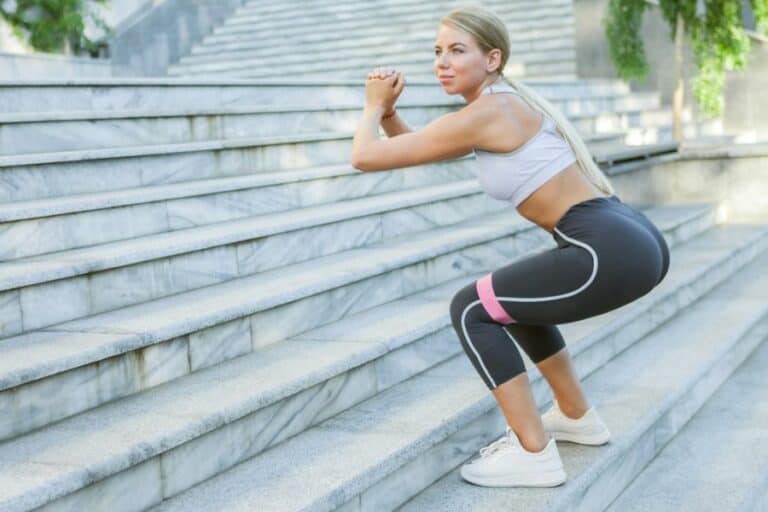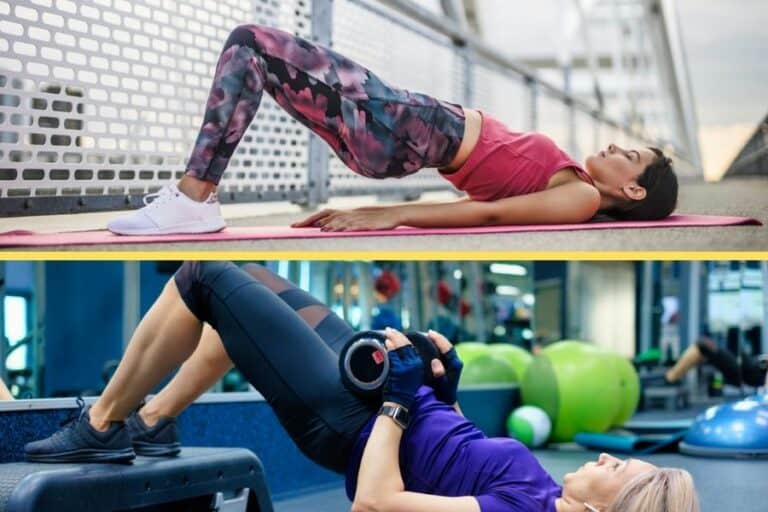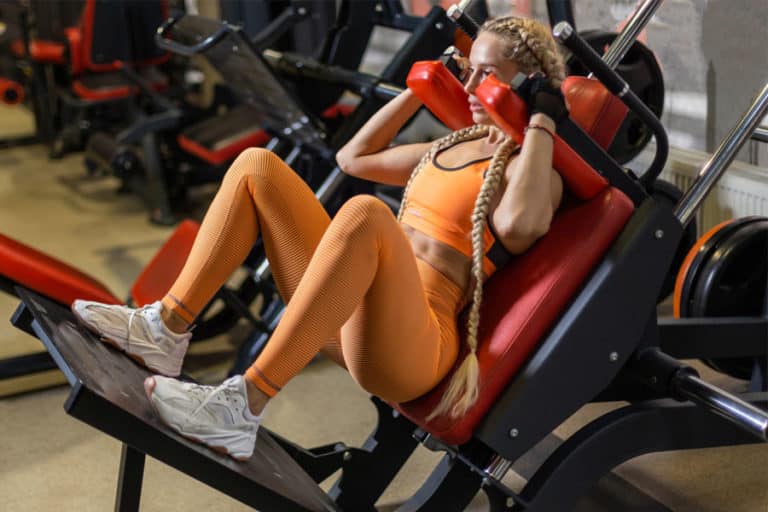Pulse Squats- How to do, Benefits, and Variations

How to do | Muscles worked | Who Should/Should Not | Add to routine | Safety Tips | Benefits | Variations | Alternatives
The pulse squat is a compound exercise that puts muscles under constant tension resulting in building increased muscles. This squat variation is a great way to target the glutes and enhance the overall strength of your legs.
Although pulse squats look like a simple exercise, you must keep up a steady rate of pulsing (movement) throughout the exercise to get significant results.
How to do pulse squats?
Pulse squats are a variation of the traditional squat. It requires you to hold a parallel or slightly deep squat position and pulse your hips up and down.
Here are the steps you can follow to do pulse squats with proper form:
- Stand with your feet shoulder-width apart.
- Keep your back straight, chin tucked, and neck aligned with your torso.
- You can also hold your arms clasped in the front or extended straight ahead for balance.
- Bend your knees, lower your hip, and squat until your thighs are parallel to the ground or a little past parallel (if you need a better stretch).
- Once you are in the squat position, pulse your hips up and down by 1 to 2 inches.
- Return to the starting position.
Note: Generally, three pulses make one squat pulse rep. However, the height and number of pulses vary from person to person.
Muscles worked with squat pulses
Here is the list of muscles that are worked in pulse squats.
Primary muscles worked
| Glutes | gluteus maximus, gluteus minimus, and gluteus medius |
| Quadriceps | rectus femoris, vastus lateralis, vastus intermedius, vastus medialis |
| Adductors | adductor brevis, adductor longus, adductor magnus, pectineus and gracilis |
Secondary muscles worked
| Hip flexors | iliopsoas and rectus femoris |
| Hamstrings | biceps femoris, semimembranosus |
| Calf muscles | gastrocnemius, and soleus |
| Core muscles | rectus abdominis, transverse abdominis, internal obliques and external obliques |
Who should and should not do squat pulse?
Despite being an excellent exercise for toning your legs and improving your squatting technique, pulse squats are not recommended for everyone. Below is the list of who should and should not do pulse squats.
Who should do squat pulses?
- Pulse squat is a convenient variation for people who don’t own any fitness equipment.
- Include squat pulses in your lower body training routine if you aim to build or tone your glutes and hamstrings without building muscle in the quads.
- Fitness volt [1]Fitness Volt: How to Do Squat Pulses suggests that squat pulses are suitable for people with less severe types of knee pain. However, it is only recommended when the individual doesn’t go too deep and bounces instead of pulse.
Who should skip squat pulses?
- Anyone with a medical condition like a hernia or hip injury should avoid a squat pulse.
- As the muscle growth in pulse squats is comparatively minimal, it may not be suitable for people who need a good muscle build. You can try other lower-body exercises if you have access to equipment like a dumbbell or kettlebell.
Adding it to your routine
Here are two sample circuits to add squat pulses into your exercise program. The first is for beginners, and the second circuit is for intermediate to advanced-level fitness lovers
Beginner level
If you are at a beginner level in your fitness journey, follow this workout routine:
| Beginner Level Exercises | Reps |
| Warm-up (Jumping rope) | 2-3 minutes with 30 seconds intervals after each minute |
| Calf raises | 3 sets of 6-8 reps |
| Bodyweight pause squat | 2-3 sets of 6-8 reps |
| Air squat | 2-3 sets of 8-10 reps |
| Pulse squat | 2-3 sets of 6-8 reps (3 pulses per rep) |
Intermediate/ Advanced level
If you want to target and strengthen your lower body muscles, here is an intermediate to advanced lower body training circuit you can try.
| Intermediate/Advanced Level Exercises | Reps |
| Warm-up (Butt kicks) | 2-3 minutes with 30 seconds intervals after each minute |
| Glute bridge | 2-4 sets of 15-20 reps |
| Curtsy lunge | 2-4 sets of 10-15 reps (on each side) |
| Goblet squat | 2-4 sets of 15-25 reps |
| Pulse squats (use dumbbell or kettlebell to add difficulty) | 4 sets of 12-15 reps (6 pulses per rep) |
Key points to consider
Besides proper form, here are a few points to keep in mind to get maximum results from pulse squats.
Pulse more
Squat pulses demand extra effort to yield higher benefits. This is because squat pulses are usually done with little or no weight. Pulse longer during each repetition to maximize your muscle growth.
Stay low
To increase the intensity of the workout, stay low when you do squat pulses. As you pulse up, keep a slight bend in your knees and rise up only a few inches higher than the squat position. This will create more muscle tension and makes your movement much more effective.
Don’t rest between reps
If you want to rely on pulse squats for overall lower body strength, refrain from taking rest between reps. To feel the burn in muscles, control the urge to pause after each rep.
Benefits of pulse squats
Squat pulses have a series of benefits that can boost your functional strength. Here are a few benefits of performing squat pulse.
1. Keeps you functional
Pulse squats need a tremendous amount of core strength and control to maintain balance and stability. This core strength automatically spills over to our daily activities. This, in turn, keeps you functional.
2. Knee joint friendly
Unlike other squat variations, squat pulses require a less range of motion around the legs. This means your knees are not quite exposed to wear and tear as much as it is in full squats.
Variations of pulse squats
Pulse squats have a versatility that can be adapted into several variations. Here are the most common variations of squat pulses.
1. Goblet squat pulse
Once you master bodyweight squat pulses, add some more challenge to it with a goblet squat. It is a great free-weight exercise that can be done with a kettlebell or dumbbell.
2. Bulgarian split squat pulse
Unilateral [2]Colorado State University: Should you be doing more unilateral training? exercises are an excellent way to add intensity to your workout. Consider combining the Bulgarian split squat with the pulse squat for a little more challenge and unilateral benefits. However, to progress to this squat, you need to gain hip mobility and balance.
3. Jump pulse squat
If you want to advance in pulse squats, a jump squat with pulses is an effective option. This variation of pulse squat will force your muscles to work harder and, indeed, turn it into a metabolic conditioning exercise (metcon) [3]National Library of Medicine: Changes in body composition, bone metabolism, strength, and skill-specific performance resulting from 16-weeks of HIFT.
4. Sumo squat pulses
The sumo pulse squat is a variation of the pulse squat that involves a wider stance. This allows you to increase adductors engagement [4]PubMed: The Activation of Gluteal, Thigh, and Lower Back Muscles in Different Squat Variations Performed by Competitive Bodybuilders: Implications for Resistance Training and improves hip mobility. Although sumo squat is a leg exercise, weighted sumo squat pulses can activate the upper body muscles as well.
Pulse squats alternative
Here are some alternatives to pulse squats that you can try for some added challenge:
Lunge pulse
Lunge pulses are a variation of basic lunges. As your weight is split in favor of your front leg, this is a considerably more complex exercise than the basic pulse squat.
Glute bridge pulse
The glute bridge targets your posterior chain muscles, and when you add pulsing to it, it makes the exercise even more challenging. As the name suggests, glute bridge pulses work tremendously on your glutes.
Conclusion
A pulse squat can be a great finishing exercise to your leg day workout routine. Whether you want to level up your lower body movement or tone your legs, a pulse squat is worth adding to your routine. However, if you have a history of injuries, always consult a certified personal trainer before trying any new squat variation.
References
| ↑1 | Fitness Volt: How to Do Squat Pulses |
|---|---|
| ↑2 | Colorado State University: Should you be doing more unilateral training? |
| ↑3 | National Library of Medicine: Changes in body composition, bone metabolism, strength, and skill-specific performance resulting from 16-weeks of HIFT |
| ↑4 | PubMed: The Activation of Gluteal, Thigh, and Lower Back Muscles in Different Squat Variations Performed by Competitive Bodybuilders: Implications for Resistance Training |


